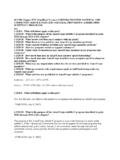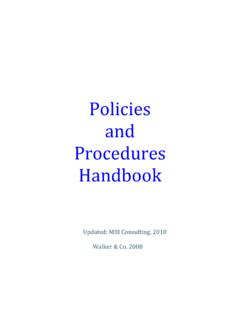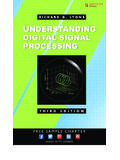Transcription of Evaluation Designs Slides - Corporation for National and ...
1 Evaluation DesignsAdrienne DiTommaso, MPA, CNCS Office of Research and Evaluation Learning objectivesBy the end of this presentation, you will be able to: Explain Evaluation design Describe the differences between types of Evaluation Designs Identify the key elements of each type of Evaluation design Understand the key considerations in selecting a design for conducting an Evaluation of your AmeriCorps programWhat is Evaluation design ? Evaluation design is the structure that provides the information needed to answer each of your Evaluation questions. Your intended Evaluation design should be based on and aligned with the following: Your program s theory of change and logic model Primary purpose of the Evaluation and key research questions Resources available for the Evaluation Funder s Evaluation requirementsEvaluation Designs and CNCS requirementsEvaluation Study DesignsMeet RequirementsLarge GranteesSmall Grantees/EAP ProgramsProcess design (Non-Experimental design Studies)NoYesOutcome design (Non-Experimental design Studies)NoYesOutcome (Impact) design (Quasi-Experimental* or Experimental design Studies)
2 YesYes*Fulfills CNCS Evaluation design requirement for large, recompeting grantees if a reasonable comparison group is identified and appropriate matching/propensity scoring is used in the types of Evaluation designsThe two sides of a program s logic model align with the two types of Evaluation Designs : Process and evaluationGoals: Documents what the program is doing Documents to what extent and how consistently the program has been implemented as intended Informs changes or improvements in the program s operationsCommon features: Does not require a comparison group Includes qualitative and quantitative data collection Does not require advanced statistical methodsProcess Evaluation designsCommon methods include: Review of program documents and records Review of administrative data Interviews, focus group Direct observationTypes of analysis: Thematic identification Confirmation of findings across sources (triangulation)Facilitated example: Process evaluationEvaluation design Crosswalk: Process EvaluationResearch questionEvaluation designMethods Data to be collected, when, and by whomAnalysis planWhat kinds of clients are seeking financial education services?
3 How are clients accessing the program?Process Evaluation Client interviews (25) Document review: client intake forms, member activity logs Client interviews (same as above) Partner focus groups (4) Evaluator will conduct interviews when clients begin program Documents reviewed quarterly (Same interview as above) Evaluator will hold focus groups quarterly Thematic analysis on interview transcripts using NVivo Coding and thematic analysis (Same as above) Thematic analysis on transcripts using NVivoOutcome evaluationGoals: Identifies the results or effects of a program Measures program beneficiaries' changes in knowledge, attitude(s), and/or behavior(s) that result from a programCommon Features.
4 Typically requires quantitative data Often requires advanced statistical methods May include a comparison group (impact Evaluation )What is a comparison or control group? A group of individuals not participating in the program or receiving the intervention Necessary to determine if the program, rather than some other factor, is causing observed changes Comparison group is associated with a quasi-experimental design and control group is associated with an experimental designOutcome Evaluation designsPre-testTreatmentPost-testa) Single group post-testX0b) Single group pre- and post-test0X0 Non-experimental Designs Outcomes are only tracked for the intervention group There are several variations within the category of non-experimental outcome Designs , differing only in number and timing of outcome measurement points.
5 A)Single group post-testb)Single group pre- and post-testX = intervention is administered 0 = measurement is takenIntervention GroupPre-testTreatmentPost-testIntervent ion Group0X0 Comparison Group00 Quasi-experimental Designs Defined by collecting data on two or more study groups an intervention group and a comparison group The intervention and comparison groups are identified from pre-existing or self-selected groups and are not formed through a random assignment process Pre-existing differences between the intervention and comparison groups at the outset of the intervention may lead to inaccurate estimates of the program s effectsX = intervention is administered 0 = measurement
6 Is takenTypes of quasi-experimental Designs Regression discontinuity Differences-in-differences Comparative interrupted time series Pre/post-test with matched comparison group Group constructed using: Propensity score matching Case matching Instrumental variableExperimental Designs Defined by collecting data on two or more study groups an intervention group and a control group Random assignment techniques ( , lottery draw) are used by the evaluator to assign study participants to either the intervention or the control group Random assignment ensures the study groups are equivalent prior to intervention, thus are often considered the most credible design to show impactPre-testTreatment Post-testIntervention GroupRandomlyassigned0X 0 Control GroupRandomlyassigned00X = intervention is administered 0 = measurement is takenFacilitated example.
7 Outcome evaluationEvaluation design Crosswalk: Outcome EvaluationResearch questionEvaluation designMethods Data to be collected, when, and by whomAnalysis planDo clients exit the program with increased knowledge of personal finance concepts relevant to their needs?Outcome evaluationRandomized control trial clients will be randomly assigned to treatment at time of application to program Control group individuals deferred for 6 months, then eligible to participate in program Client and control group knowledge of personal finance concepts Pre test: during application; post test: for treatment group, upon completion of program. For control group, at 6 months post deferment Collected by evaluator via paper and pencil and online survey Statistical analysis descriptive statistics.
8 Between groups T test using STATA softwareEvaluation Designs and CNCS requirementsEvaluation Study DesignsMeet RequirementsLarge GranteesSmall Grantees/EAP ProgramsProcess design (Non-Experimental design Studies)NoYesOutcome design (Non-Experimental design Studies)NoYesOutcome (Impact) design (Quasi-Experimental* or Experimental design Studies)YesYes*Fulfills CNCS Evaluation design requirement for large, recompeting grantees if a reasonable comparison group is identified and appropriate matching/propensity scoring is used in the









